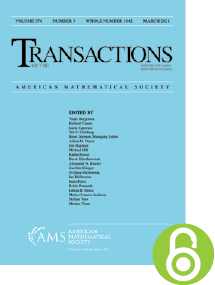On bounded functions satisfying averaging conditions. I
HTML articles powered by AMS MathViewer
- by Rotraut Goubau Cahill PDF
- Trans. Amer. Math. Soc. 206 (1975), 163-174 Request permission
Abstract:
Let $R(T)$ be the space of real valued ${L^\infty }$ functions defined on the unit circle $C$ consisting of those functions $f$ for which $li{m_{h \to 0}}(1/h)\int _\theta ^{\theta + h} {f({e^{it}})dt = f({e^{i\theta }})}$ for every ${e^{i\theta }}$ in $C$. The extreme points of the unit ball of $R(T)$ are found and the extreme points of the unit ball of the space of all bounded harmonic functions in the unit disc which have non-tangential limit at each point of the unit circle are characterized. We show that if $g$ is a real valued function in ${L^\infty }(C)$ and if $K$ is a closed subset of $\{ {e^{i\theta }}|li{m_{h \to 0}}(1/h)\int _\theta ^{\theta + h} {g({e^{it}})dt = g({e^{i\theta }})\} }$, then there is a function in $R(T)$ whose restriction to $K$ is $g$. If $E$ is a ${G_\delta }$ subset of $C$ of measure 0 and if $F$ is a closed subset of $C$ disjoint from $E$, there is a function of norm 1 in $R(T)$ which is on $E$ and 1 on $F$. Finally, we show that if $E$ and $F$ are as in the preceding result, then there is a function of norm 1 in ${H^\infty }$ (unit disc) the modulus of which has radial limit along every radius, which has radial limit of modulus 1 at each point of $F$ and radial limit 0 at each point of $E$.References
- T. K. Boehme, M. Rosenfeld, and Max L. Weiss, Relations between bounded analytic functions and their boundary functions, J. London Math. Soc. (2) 1 (1969), 609–618. MR 249627, DOI 10.1112/jlms/s2-1.1.609 M. Denjoy, Sur une propriété des fonctions dérivées, Enseignement Math. 18 (1916), 320-328.
- Maurice Heins, Some remarks concerning nonnegative harmonic functions, J. Approximation Theory 5 (1972), 118–122. MR 344486, DOI 10.1016/0021-9045(72)90034-2
- Kenneth Hoffman, Banach spaces of analytic functions, Prentice-Hall Series in Modern Analysis, Prentice-Hall, Inc., Englewood Cliffs, N.J., 1962. MR 0133008
- A. J. Lohwater and G. Piranian, The boundary behavior of functions analytic in a disk, Ann. Acad. Sci. Fenn. Ser. A. I. 1957 (1957), no. 239, 17. MR 91342
- Lynn H. Loomis, The converse of the Fatou theorem for positive harmonic functions, Trans. Amer. Math. Soc. 53 (1943), 239–250. MR 7832, DOI 10.1090/S0002-9947-1943-0007832-1 S. Saks, Theory of the integral, Monografie Mat., vol 7, Warsaw, 1937.
- Zygmunt Zahorski, Über die Menge der Punkte in welchen die Ableitung unendlich ist, Tôhoku Math. J. 48 (1941), 321–330 (German). MR 27825
Additional Information
- © Copyright 1975 American Mathematical Society
- Journal: Trans. Amer. Math. Soc. 206 (1975), 163-174
- MSC: Primary 30A76; Secondary 31A05
- DOI: https://doi.org/10.1090/S0002-9947-1975-0367208-5
- MathSciNet review: 0367208


